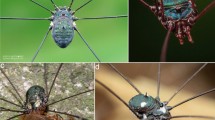Summary
The web of Polenecia producta is interpreted as being a modified orb web. The position of the hub directly upon a twig amongst irregularly placed branches decides the web's structure. Since the radii have to be fixed in the vicinity corresponding to the local possibilities, and since these possibilities vary very much from case to case, a great variety of web scaffoldings results. All of them are characterized by a lack of symmetry. These asymmetries, for their part, prevent the production of capture threads by circling around and fixing them obliquely to the radii as do orb weavers. P. producta adapts itself to this situation by attaching the adhesive material along the radii. Under these circumstances temporary spirals, like those of orb weavers, would be without function. The short pieces of such spirals present in the webs of P. producta are interpreted as vestiges of once functional structures. The silk deposits P. producta lays down upon the hub can, in certain respects, be compared with stabilimenta of other Uloboridae. The relatively late onset of web building in P. producta (instar II spiderlings) is related to the ontogeny of the spinning apparatus.
Similar content being viewed by others
References
Downes MF (1987) A proposal for standardization of the terms used to describe the early development of spiders, based on a study of Theridion rufipes Lucas (Araneae, Theridiidae). Bull Br Archnol Soc 7:187–193
Eberhard WG (1977) The webs of newly emerged Uloborus diversus and of a male Uloborus sp. (Araneae, Uloboridae). J Arachnol 4:201–206
Eberhard WG (1985) The “sawtoothed” orb web of Eustala sp. (Araneae, Araneidae) with a discussion of ontogenetic changes in spiders' web-building behavior. Psyche 92:105–117
Kaston BJ (1964) The evolution of spider webs. Am Zool 4:191–207
Kovoor J, Peters HM (1988) The spinning apparatus of Polenecia producta (Araneae, Uloboridae): structure and histochemistry. Zoomorphology 108:47–59
Kullmann EJ (1972) The convergent development of orb-webs in cribellate and ecribellate spiders. Am Zool 12:395–405
Nentwig W, Heimer St (1983) Orb webs and single-line webs: an economic consequence of space web reduction in spiders. Z Zool Syst Evolutionsforsch 21:26–37
Opell BD (1979) Revision of the genera and tropical American species of the spider family Uloboridae. Bull Mus Comp Zool (Cambridge, Mass) 148:443–549
Peters HM (1982) Wie Spinnen der Familie Uloboridae ihre Beute einspinnen und verzehren. Verh Naturwiss Ver Hamburg (NF) 25:147–167
Peters HM (1983) Struktur und Herstellung von Fangfäden cribellater Spinnen. Verh Naturwiss Ver Hamburg (NF) 26:241–253
Peters HM (1984) The spinning apparatus of Uloboridae in relation to the structure and construction of capture threads (Arachnida, Araneida). Zoomorphology 104:96–104
Peters HM (1987) Fine structure and function of capture threads. In: Nentwig W (ed) Ecophysiology of spiders: 187–202 Springer, Berlin Heidelberg New York London Paris Tokyo
Peters HM (1990) On the structure and glandular origin of bridging lines used by spiders for moving to distant places. Acta Zool Fenn 190:309–314
Peters HM (1993) Über das Problem der Stabilimente in Spinnennetzen. On the problem of the stabilimenta in spider webs. Zool Jahrb Physiol 97:245–264
Peters HM, Kovoor J (1980) Un complément à l'appareil séricigène des Uloboridae (Araneae): le paracribellum et ses glandes. Zoomorphology 96:91–102
Peters HM, Kovoor J (1989) Die Herstellung der Eierkokons bei der Spinne Polenecia producta (Simon, 1873) in Beziehung zu den Leistungen des Spinnapparates. The construction of eggcases by the spider Polenecia producta (Simon, 1873) in relation to the functions of the spinning apparatus. Zool Jahrb Physiol 93:125–144
Szlep R (1961) Developmental changes in the web spinning instinct of Uloboridae: Construction of the primary-type web. Behaviour 17:60–70
Wiehle H (1931) Neue Beiträge zur Kenntnis der Fanggewebe der Spinnen aus den Familien Argiopidae, Uloboridae und Theridiidae. Z Morphol Ökol Tiere 22:348–400
Author information
Authors and Affiliations
Rights and permissions
About this article
Cite this article
Peters, H.M. Polenecia producta and its web: structure and evolution (Araneae, Uloboridae). Zoomorphology 115, 1–9 (1995). https://doi.org/10.1007/BF00397930
Accepted:
Issue Date:
DOI: https://doi.org/10.1007/BF00397930




